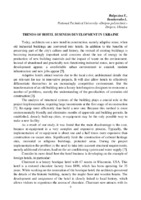Показати скорочений опис матеріалу
TRENDS OF HOTEL BUSINESS DEVELOPMENT IN UKRAINE
| dc.contributor.author | Baiguzina, E. | |
| dc.contributor.author | Bondarenko, L. | |
| dc.date.accessioned | 2021-06-14T13:05:14Z | |
| dc.date.available | 2021-06-14T13:05:14Z | |
| dc.date.issued | 2021-05-12 | |
| dc.identifier.uri | http://ir.nmu.org.ua/handle/123456789/157965 | |
| dc.description.abstract | The analysis of structural systems of the building plays a crucial role in the project implementation, requiring large investments at the first stage of reconstruction. Re-equip more efficiently than build a new one. Because this method is more environmentally friendly and eliminates months of approvals and building permits. In established, densely built-up cities, re-equipment may be the only possible way to make a new facility. As a result of our study, it was found that the main disadvantage is the cost, because re-equipment is a very complex and expensive process. Typically, the implementation of re-equipment is about one and a half times more expensive than construction on vacant sites. Significantly limit the construction of cultural heritage sites, memorial or religious buildings, protected areas. During the project implementation the problem is the need to take into account structural requirements, namely additional elevators, load on the air conditioning system and water supply. | uk_UA |
| dc.language.iso | en | uk_UA |
| dc.subject | TRENDS OF HOTEL BUSINESS DEVELOPMENT IN UKRAINE | uk_UA |
| dc.title | TRENDS OF HOTEL BUSINESS DEVELOPMENT IN UKRAINE | uk_UA |
| dc.type | Article | uk_UA |
| dc.identifier.udk | 338:48 | uk_UA |

